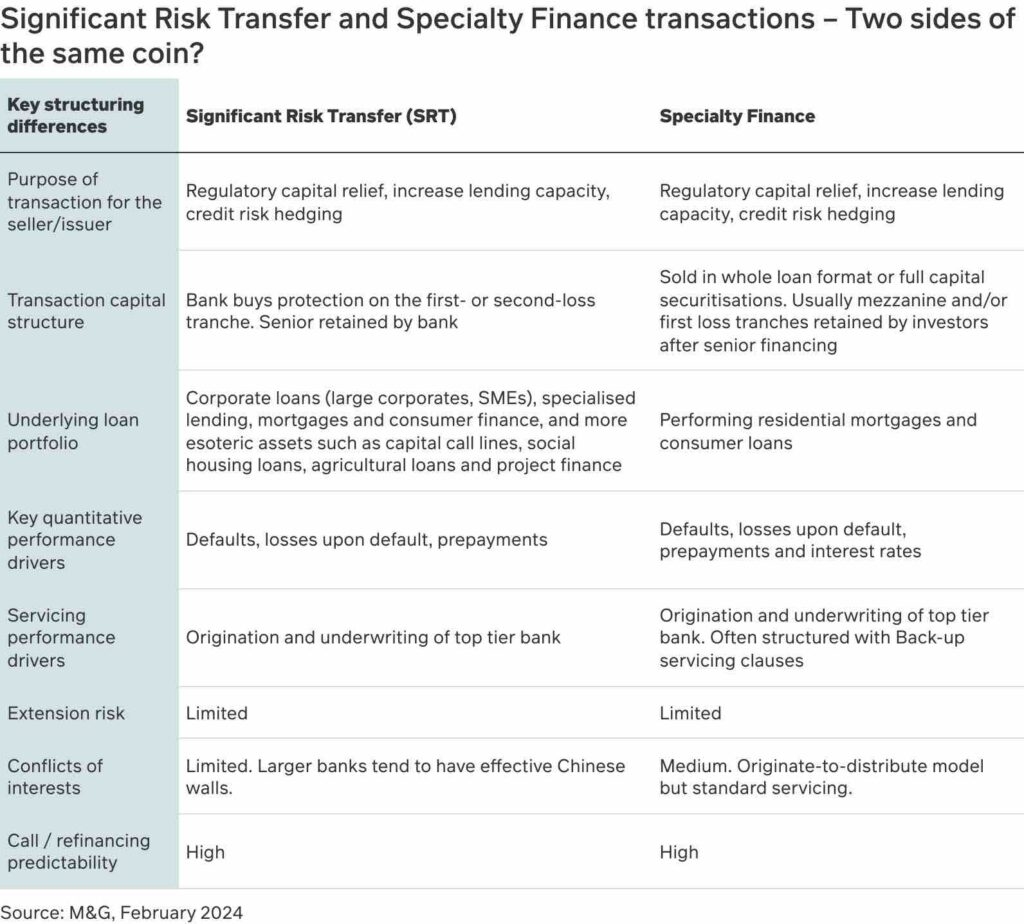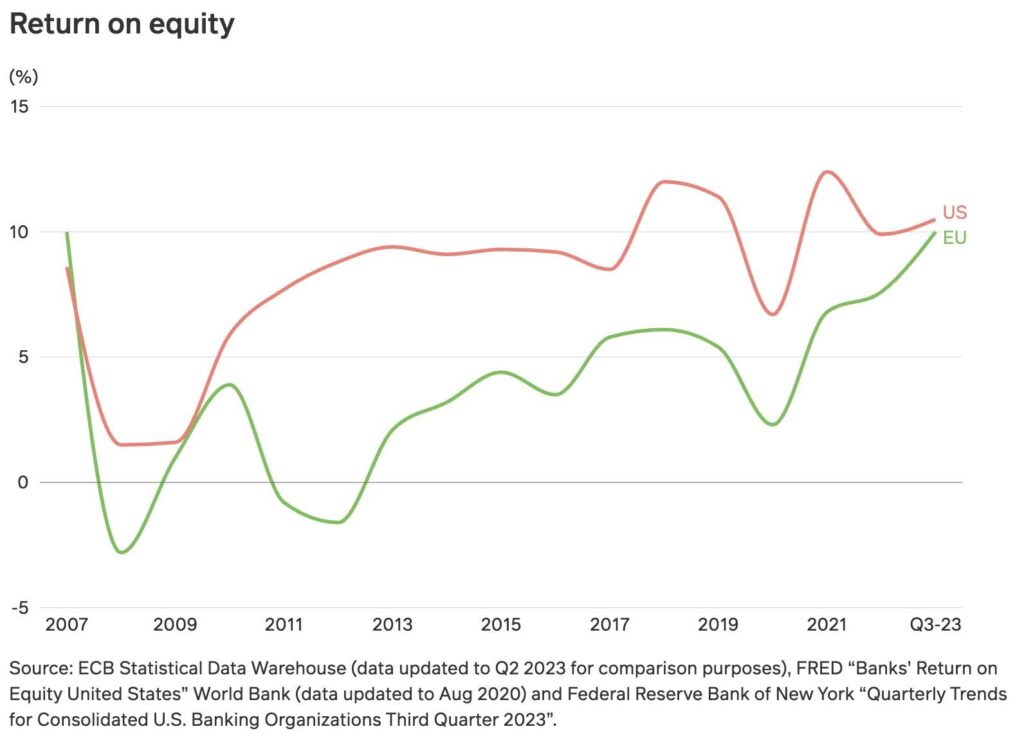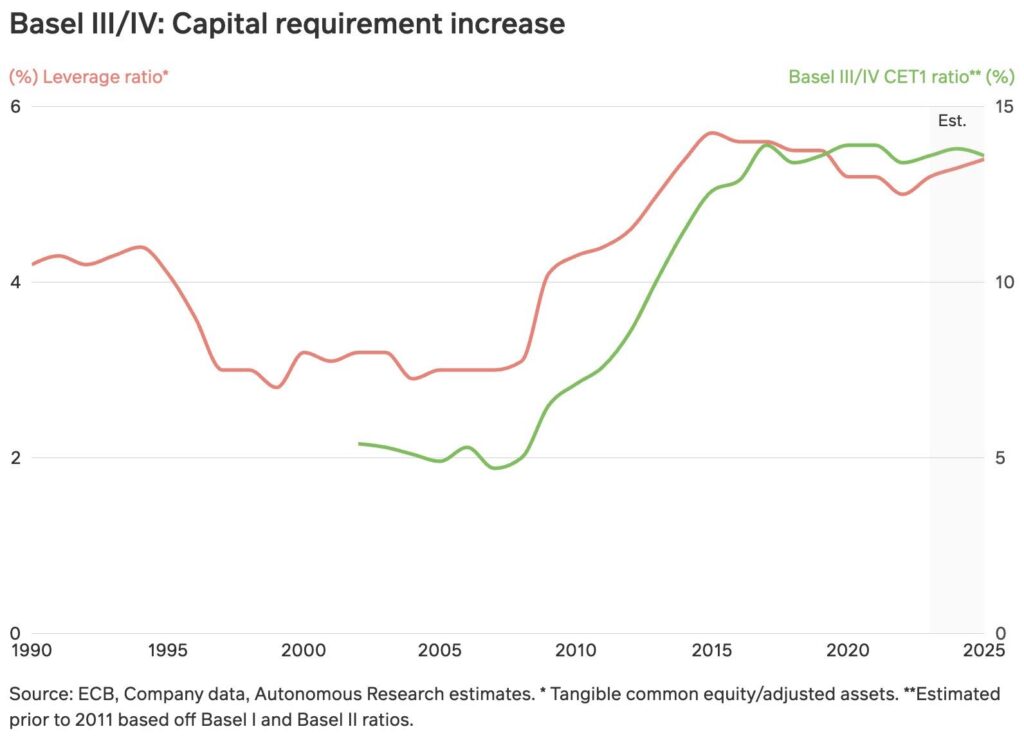By James King, Head of Structured Credit, and Jo Tomkins, Investment Specialist – Structured Credit at M&G Investments
The structural need for European banks to deleverage, particularly with new capital rules under Basel IV coming into effect from 2025 (dubbed as the Basel “Endgame”), is incentivising banks to engage in ‘risk-sharing’ regulatory capital solutions like Significant Risk Transfer and other asset solutions such as Specialty Finance trades. As banks double-down on capital relief and balance sheet optimisation, this is creating an attractive and unique entry point for investors to gain exposure to the core, yet ‘harder-to-access’, parts of bank balance sheets and earn potentially attractive risk-adjusted returns.
The Basel III Endgame
Debate over the Basel “Endgame” rules has racked up column inches over recent months (and years) and set to have far-reaching implications for banks in the EU, UK, and particularly the US – with the proposed US Endgame rules more punitive than the European proposals if implemented in their current form.
The Endgame represents the final phase of Basel III requirements (also known as “Basel IV”), with European regulators having agreed the additional capital rules in 2017 as part of the overarching Basel III Framework developed in response to the Global Financial Crisis (GFC). Most large European banks have increased their common equity Tier 1 (CET1) ratios since 2017 and the bloc’s biggest banks appear well positioned to navigate the implementation of the final reforms.
Although Basel has a 2028 deadline for implementation, the rules are set to be rolled out in the EU from 1 January 2025 (and from 1 July 2025 in the UK and the US), the phase-in period runs until 1 Jan 2030. While this seems a long time away the impact of the final reforms is already prompting many banks to rethink capital allocation and focus on optimising their balance sheets to adapt to major risk-weighted asset (RWA) calculation changes. As a reminder, “risk-weighted assets” measure how much capital banks need to hold against the risks they are taking.
One of the key developments of Basel IV is the introduction of an ‘output floor’ – a measure that limits banks’ use of internal models to assess the riskiness of their assets – which is expected to push up capital consumption especially for large banks. It will become more expensive for banks to keep high-quality residential mortgages and unrated corporate loans on their balance sheets once the risk weighting floors are phased in. The risk weighting of mortgages is therefore set to increase five-fold compared to Basel III, for example. Under current regulations, many banks have used internal modelling, rather than standardised modelling, to keep lower risk weights on such loans given their historically low default rates.
Few alternatives to asset sales and risk-sharing transactions
Over the years so-called ‘risk-sharing’ regulatory capital solutions, like Significant Risk Transfer (SRT) transactions, and core asset/portfolio sales have emerged as critical tools in enabling banks, particularly European banks, to sell junior risk (or buy protection in the case of SRT) on portfolios to address regulatory capital issues, optimise their balance sheets and boost profitability in the context of ever-growing regulatory capital requirements brought in following the GFC.
Significant Risk Transfer: SRT transactions effectively help banks to manage their RWA exposures by transferring the credit risk on a portfolio of assets to third-party investors either via a true sale securitisation or a synthetic transaction so that they obtain regulatory capital relief on that portfolio, while allowing banks to keep the loans on-balance sheet and maintain key customer relationships.
Asset/portfolio sales: With these transactions, banks are typically looking for risk limit headroom or to increase their ‘capital velocity’ and are increasingly selling whole pools of typically seasoned, and performing loans to selected institutional investors – while still servicing the loan assets for a fee and maintaining relationships with end-consumers. Structuring for full asset derecognition and/or regulatory capital relief may be the preferred solution for certain asset types that are more capital-intensive from a regulatory standpoint or where portfolio sales arise as part of a lender’s strategic pullback/exit from certain markets or geographies that are no longer core to them. These asset-backed transactions tend to be labelled as ‘Specialty Finance’ transactions or form a core part of the growing ‘Asset-Backed Finance (ABF)’ complex.
In both instances, securitisations are executed mostly privately owing to the higher barriers to entry (largely self-imposed) and inherent complexity involved in these transactions, particularly in Europe. In these markets, premiums have remained for structuring, complexity and illiquidity together with less competition for assets which has created a clear supply and demand imbalance.

There is the possibility that a debtor will not meet their repayment obligations. Investments may be illiquid and, as a result, it may be difficult to realise, sell or dispose of an investment at an attractive price or at the appropriate time or in response to changing market conditions. Due to their limited number, investments may be affected adversely by the unfavourable performance of an asset.
Growing investment opportunities
Given the evolving regulatory backdrop, there remains clear motives for banks to continue to engage in these transactions. In turn, SRT and Specialty Finance offer potentially attractive ways for institutional investors to capitalise on the bank deleveraging trend by gaining exposure to traditionally harder-to-access parts of banks core performing lending books, while earning potentially attractive risk-adjusted returns – with volumes and pricing typically less volatile than public securitisation/ABS markets. The US has a much more developed private finance sector which, in our view, is much more competitive and therefore less interesting from a return perspective than Europe.

Getting ahead of the regulatory curve
With the Basel Endgame now firmly in sight there is a race for banks to get deals done now under the current rules to achieve maximum regulatory capital benefit until Basel IV is implemented.
In the context of SRT, its worth highlighting that the output floor also applies to the senior retained tranches of securitisation, which is not the case under the current rules. Therefore, it will also likely mean that existing risk transfer deals will need to be thicker in terms of tranching to achieve efficient capital reduction on any given portfolio, creating a requirement for mezzanine as well as first-loss risk financing.
Equally, changes in the RWA calculations makes it more likely that low-risk asset classes that had attracted a low capital charge, including prime mortgages and consumer loans, will lend themselves to SRT transactions, with the focus potentially shifting to lower risk exposures and the most heavily-impacted assets on bank balance sheets.
The European bank retrenchment story continues
The retail banking market still dominates corporate and consumer finance within Europe, even in the UK, unlike the US which has transitioned to a more ‘market-based’ lending ecosystem since pre-GFC thanks to the entry of non-bank lenders and servicers. Although there is further to go in Europe in terms of bank disintermediation, traditional bank lenders came out of the GFC with narrower lending remits due to tighter regulation and capital pressures. This, in itself, created financing gaps in certain segments of the economy which has given rise to the entry of innovative, non-bank platforms– including buy-to-let (BTL) and specialist mortgage lending, auto loans and leases, personal loans/credit and other consumer receivables – which is fuelling growing asset-backed financing opportunities in the real economy for patient capital providers.
At the same time bank capital requirements continue to increase due to the multi-year phase-in of regulations, while European bank return on equity (RoE) has been pretty poor over the past 15 years and lagged behind US banking peers. While profitability has improved in recent quarters (owing largely to higher net interest margins (NIMs)), European banks still trade well below book value and P/E multiples have widened further and are reportedly close to all-time lows relative to US banks.

The transition from Basel III to Basel IV looks likely to mean greater capital requirements across the board and a multi-year process, incentivising banks to either transfer risk by utilising capital relief transactions or be more predisposed towards selling core assets as part of the overall menu of options to deal with this problem – including raising more CET1 or AT1, shrinking their balance sheet and lending for shorter tenors or further up the risk spectrum.

In our view there is a significant and compelling opportunity for investors to make a meaningful allocation to relatively new markets which exist because of long-term secular trends in the banking markets across the globe. These structural and secular trends have plenty of room to run and look set to dominate the landscape in the years to come.
Find out more:
Listen to The Investment Podcast from M&G Investments to hear James King, Head of Structured Credit and Jo Tomkins, Investment Specialist – Structured Credit further discuss why they think the Significant Risk Transfer market is poised for significant growth over the coming years.
For Investment Professionals only. The value of investments will fluctuate, which will cause prices to fall as well as rise and investors may not get back the original amount they invested. The views expressed in this document should not be taken as a recommendation, advice or forecast. Past performance is not a guide to future performance.



